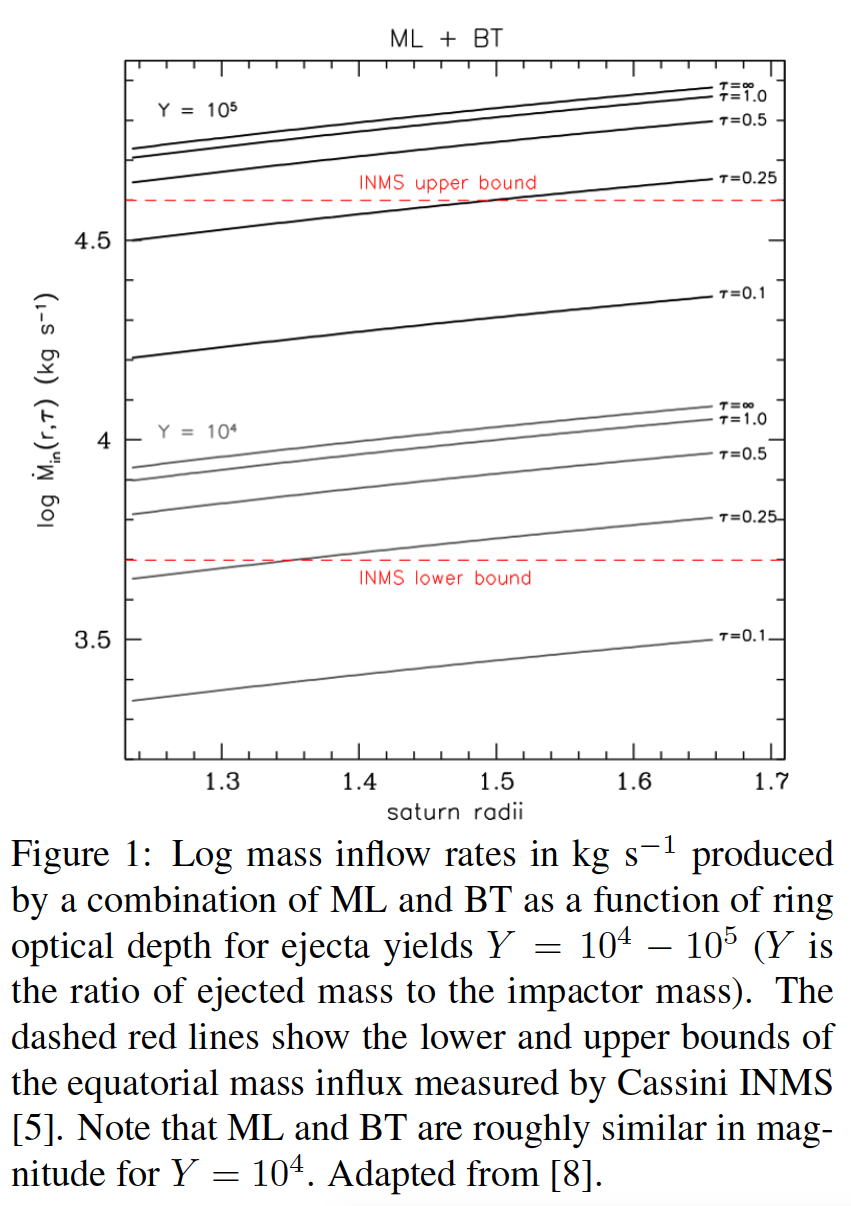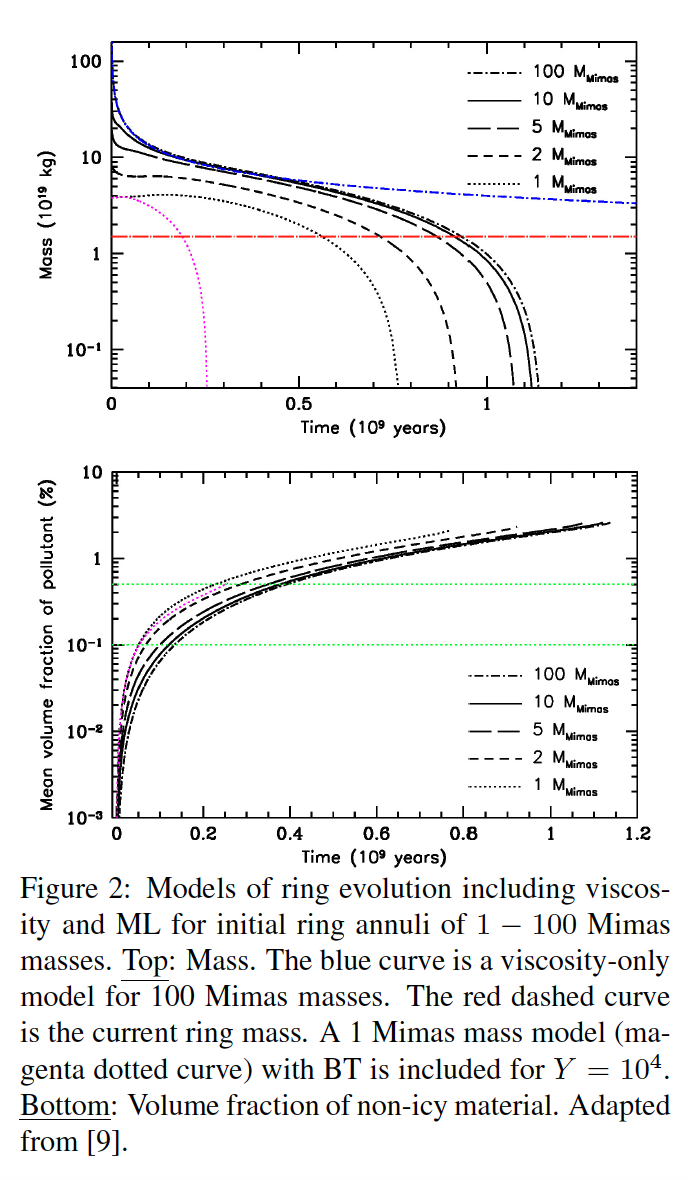Diamonds are Not Forever: Dynamical Evolution of Saturn’sRings Driven by Micrometeoroid Bombardment
- 1NASA Ames Research Center, Moffett Field, CA, 94035 USA (Paul.R.Estrada@nasa.gov),
- 2Department of Astronomy, Indiana University, Bloomington, IN, 47405 USA
1. Introduction
After more than a dozen years in orbit about Saturn, the Cassini mission provided key measurements that are important for determining the age of Saturn’s rings. These include the extrinsic micrometeoroid flux at Saturn [1], the volume fraction of non-icy pollutants in the rings [e.g., 2], and the total ring mass [3]. These factors help to constrain the ring age to be no more than a few 100 Myr [1]. The Cassini Grand Finale also provided a suite of observations that demonstrate that the rings are losing mass to the planet at a surprising rate. Some of the mass flux falls as “ring rain” at higher latitudes consistent with the H+3 infrared emission pattern thought to be produced by an influx of charged water products from the rings [e.g., 4]. The contribution needed to account for the ring rain phenomenon though is considerably less than the total equatorial measured mass influx of 4800 – 45000 kg/s [5]. Taken together, these observations imply that the rings are not only young, but also ephemeral. Here we argue that bombardment by micrometeoroids can account for these observations.
2. What’s Driving the Mass Inflow?
It has been recently argued that the above age estimate for the rings derived from exposure to micrometeoroids is not the same as their formation age, and that the rings could look young but still be quite old [6]. At their current mass, the observed mass inflow is orders of magnitude more than what viscous evolution can currently produce [7,8]. However, recall that micrometeoroid bombardment (MB) not only leads to pollution of the rings over time (as well as a catalyst for ring rain), but also to exchange of mass and angular momentum throughout the rings due to ballistic transport (BT) of their impact ejecta. As a result of this fundamental feature of BT, the rings act like an accretion disk with outward angular momentum transport leading to a steady inward drift of material to the planet. In [8], we quantify this radial drift rate in the context of a quasi-steady uniform ring using an accretion disk analog to show that for plausible choices of the ejecta yield Y , that direct deposition (mass loading, ML) of micrometeoroids and BT can produce the observed mass inflow rates (Fig. 1). More importantly it means that as ring mass decreases and viscosity can no longer effectively drive their evolution, the rings can continue to dynamically evolve driven by MB. This has implications not only for the formation age and initial mass of Saturn’s current rings, but also for the long-term evolutionary state of planetary rings.

3. Evolution Under ML & BT
In [9] we have modeled the dynamical evolution of rings with initial disk masses ranging from 1-100 Mimas under the effects of viscosity and ML (Fig. 2, upper panel). For comparison, we show (blue dashed curve) the evolution due to viscosity alone for an initial disk mass of 100 Mimas [see 7]. This occurs because the evolution of massive rings is driven very strongly early on by viscosity, but weakens at later times as the ring spreads. We find though that when we include just ML (black curves), the rings’ dynamical evolution is eventually driven more strongly by ML once a threshold mass is achieved, and the ring mass continues to decrease. This result suggests, based on ML alone, that a primordial massive ring would likely have become low mass much earlier on in Solar System history, especially if the flux was much higher in the past. If one also includes BT (shown for 1 Mimas mass, magenta dotted curve) with Y = 104 for comparison, evolution (and mass loss) is greatly accelerated leading to much shorter life times. Figure 2 (bottom) shows the corresponding pollution rates which all achieve the observed range of volume fractions (green dotted lines) of non-icy material in the A/B rings [3] in ≤ few 100 Myr timescales independent of initial mass.

4. Implications for Ring Evolution
These results suggest that if the micrometeoroid flux was relatively constant at least at its current measured value [1] then the rings cannot be ancient, regardless of their initial mass. Moreover, given the relatively short life time of rings subject to the effects of MB, it is highly unlikely then that they started so massive, so recently. We argue in [9] using lower initial mass evolutionary models that the rings appear consistent with being only ∼100 Myr old, and likely had an initial mass of ∼1-4 Mimas masses with a remaining lifetime of ≤200 Myr. In these models, we have ignored that BT manifests and plays an important role in structural evolution which imposes additional constraints strengthening this argument. Such complicated effects require more detailed models which is the subject of ooing work. In reality, we expect that rings will achieve such low mass that BT becomes inefficient at further transport, and speculate that even initially massive rings will evolve to a highly polluted, low density tenuous state similar to the rings of Uranus and Neptune. This would be in agreement with Crida and Charnoz [10] who first suggested these ice giants may have had initially massive rings.
Acknowledgements: This work was supported by a grant from NASA’s Cassini Data Analysis Program.
References:
[1] Kempf, S., et al.: In prep., 2021
[2] Zhang, Z., et al.: Icarus 294, 14-42. 2017
[3] Iess, L., et al.: Science 364, id.aat2965, 2019
[4] O’Donoghue, J., et al.: Icarus 322, 251-260, 2019
[5] Waite, J. H., et al.: Science 362, id.aat2382, 2018
[6] Crida, A. et al.: Nature Astronomy 3, 967-970, 2019
[7] Salmon, J. et al.: Icarus 209, 771-785, 2010
[8] Durisen, R. H. & Estrada, P. R.: Icarus, sub., 2021
[9] Estrada, P. R., & Durisen, R. H.: Icarus, sub., 2021
[10] Crida, A. & Charnoz, S.: Science 338, 1196, 2012
How to cite: Estrada, P. and Durisen, R. H.: Diamonds are Not Forever: Dynamical Evolution of Saturn’sRings Driven by Micrometeoroid Bombardment, European Planetary Science Congress 2021, online, 13–24 Sep 2021, EPSC2021-869, https://doi.org/10.5194/epsc2021-869, 2021.

